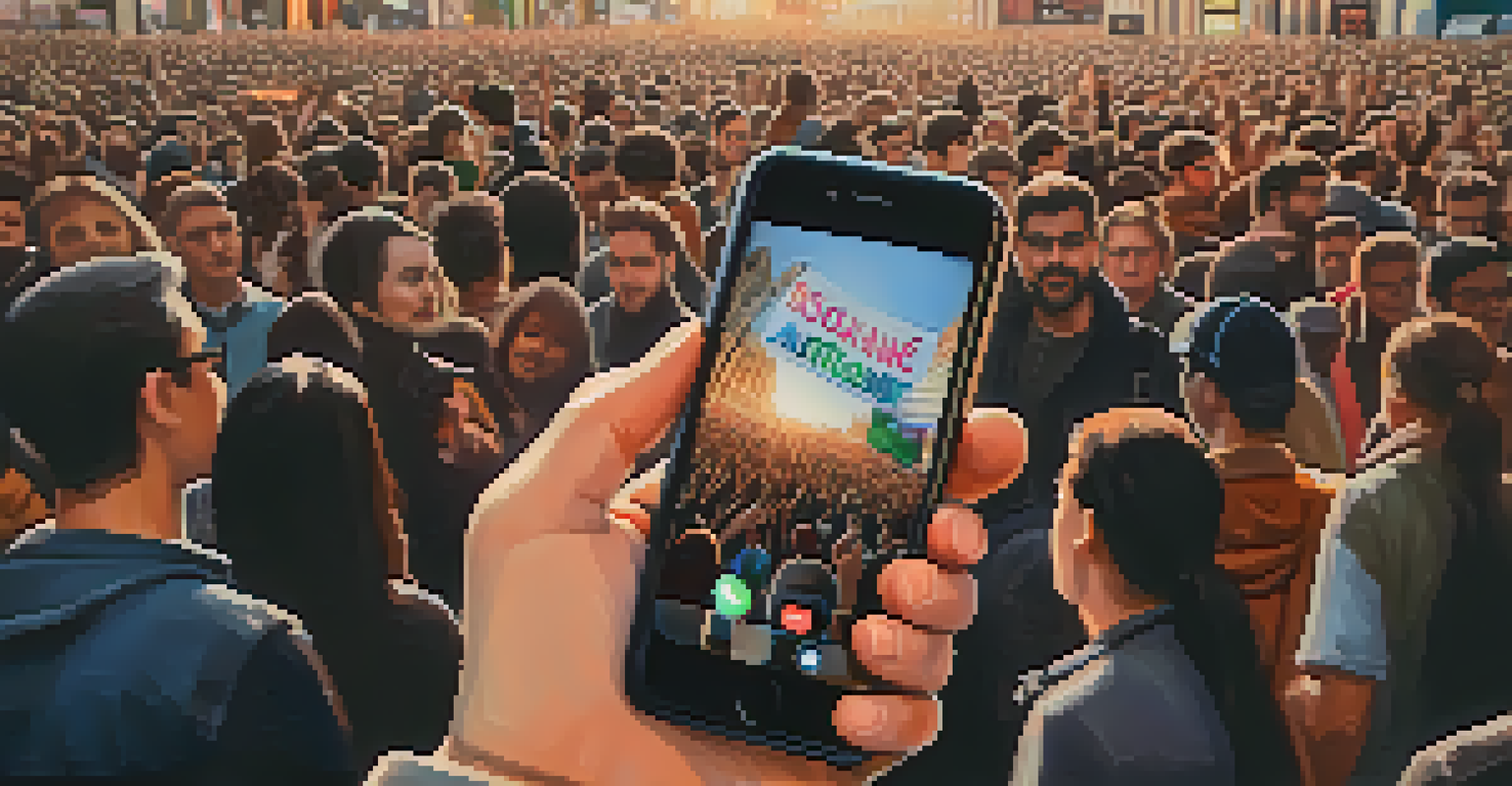The Impact of Social Media on L.A. Grassroots Movements

The Rise of Social Media in Activism
In recent years, social media has transformed how grassroots movements operate, especially in cities like Los Angeles. Platforms like Twitter, Facebook, and Instagram allow activists to share their messages widely and quickly, reaching audiences that traditional methods might miss. For instance, the hashtag #BLMLA became a rallying point for protests, illustrating how social media can amplify voices that demand change.
Social media is not just a tool for communication, but a powerful platform for mobilization and advocacy.
With the click of a button, a local event can gain international attention, bringing in support and solidarity from around the globe. This immediacy not only raises awareness but also mobilizes people faster than ever before. The ability to organize events and share information in real-time has become a game changer for activists who rely on community engagement.
Moreover, social media platforms have democratized activism, allowing anyone with internet access to participate in the conversation. This shift has led to a more diverse representation of voices, ensuring that various perspectives are heard and included in the movement's narrative.
Connecting Communities through Digital Platforms
Social media acts as a virtual bridge, connecting individuals and communities that might otherwise remain isolated. In Los Angeles, where cultural diversity is rich, social media helps unite different groups around common causes. For example, local organizations use platforms to share resources and rally support for issues that affect specific neighborhoods or communities.

These connections foster a sense of belonging and community among individuals who may feel marginalized in traditional activism settings. When people see their friends and neighbors engaging in social justice efforts online, it encourages them to join in, creating a ripple effect of participation. This sense of community is crucial for sustaining grassroots movements over time.
Social Media Empowers Activism
Platforms like Twitter and Instagram enable grassroots movements to amplify their messages and mobilize support quickly and effectively.
Additionally, social media allows for storytelling, enabling individuals to share their personal experiences related to social issues. This sharing humanizes the struggles faced by various groups, making it more relatable and motivating others to take action.
Mobilizing Action: From Online to Offline
One of the most powerful aspects of social media is its ability to turn online engagement into offline action. In Los Angeles, many grassroots movements have successfully organized protests, community meetings, and fundraising events through social media platforms. The transition from digital awareness to physical presence demonstrates the effectiveness of these tools in mobilizing support.
The future will be about collaboration, and social media provides the perfect platform to forge those connections.
For instance, during the recent climate strikes, organizers used social media to share event details, coordinate logistics, and mobilize thousands of participants across the city. This seamless transition highlights how digital strategies can enhance the impact of grassroots efforts, ensuring that the message resonates beyond the screen.
Moreover, social media provides a platform for live updates during events, allowing participants to share their experiences in real time. This not only boosts morale but also encourages others to join the movement, creating a sense of urgency and excitement.
Challenges: Misinformation and Digital Divide
While social media offers numerous benefits for grassroots movements, it also presents significant challenges, particularly regarding misinformation. False information can spread rapidly, undermining the credibility of movements and causing confusion among supporters. In Los Angeles, activists must navigate this landscape carefully to ensure their messages remain accurate and trustworthy.
Additionally, the digital divide poses a challenge, as not everyone has equal access to the internet or social media platforms. This disparity can exclude marginalized communities from participating fully in grassroots movements, limiting the diversity of voices and perspectives. Activists must find ways to bridge this gap, such as incorporating traditional outreach methods alongside digital campaigns.
Community Connection and Belonging
Social media fosters a sense of community by connecting diverse individuals around common causes, encouraging broader participation in activism.
Ultimately, addressing these challenges is essential for the long-term success of grassroots movements. By prioritizing accurate information and inclusive practices, activists can create a more equitable environment for engagement.
The Role of Influencers in Grassroots Movements
Influencers play a significant role in shaping public perceptions and spreading awareness about grassroots movements. In Los Angeles, local influencers often use their platforms to advocate for social justice causes, drawing attention to issues that need urgent action. Their reach can bring new audiences into conversations, amplifying the movement's message.
For example, when a well-known influencer shares information about a protest or campaign, it can lead to a spike in engagement and participation. This phenomenon not only increases visibility but also legitimizes the movement in the eyes of those who may have previously been unaware or indifferent. Influencers, therefore, become valuable allies in the fight for social change.
However, it’s crucial for influencers to align themselves authentically with the causes they promote. When influencers genuinely engage with grassroots movements, it fosters trust and encourages their followers to get involved. This authenticity can be a powerful catalyst for mobilizing support and creating lasting change.
Case Study: The Women's March in Los Angeles
The Women's March in Los Angeles serves as a prime example of how social media can mobilize grassroots movements. Launched in response to national events, the march attracted millions of participants, with social media playing an essential role in its organization. Through hashtags, event pages, and live updates, organizers effectively spread the word and engaged a diverse audience.
Participants shared their experiences online, creating a sense of unity and solidarity that resonated far beyond the event itself. The visibility garnered through social media not only amplified the message of gender equality but also inspired similar movements across the country and around the world. This case illustrates the profound impact social media can have on grassroots efforts, allowing them to transcend local boundaries.
Challenges of Misinformation
Despite its benefits, social media presents challenges such as misinformation and the digital divide, which can hinder effective grassroots engagement.
In the aftermath of the march, social media continued to be an essential tool for activism, with participants using their platforms to advocate for ongoing issues. The connections made during the event fostered a community that continues to engage in activism, demonstrating the lasting power of social media in grassroots movements.
The Future of Grassroots Movements and Social Media
As social media continues to evolve, so too will its role in grassroots movements. In Los Angeles, activists are increasingly exploring new platforms and technologies to engage supporters and amplify their messages. From TikTok videos to live-streamed events, the possibilities for creative expression and outreach are expanding.
Additionally, as digital literacy improves, more individuals will become equipped to navigate social media effectively, bridging the gap between different communities. This shift could lead to even greater collaboration and solidarity among diverse groups, enriching the fabric of grassroots activism in the city.

Ultimately, the future of grassroots movements in Los Angeles hinges on the ability to adapt and innovate within the digital landscape. By embracing new tools and fostering inclusive practices, activists can continue to harness the power of social media to drive meaningful change.